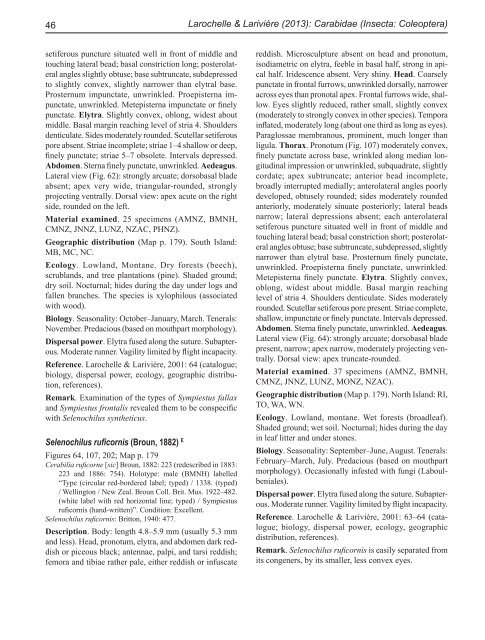Fauna of New Zealand 69 - Landcare Research
Fauna of New Zealand 69 - Landcare Research
Fauna of New Zealand 69 - Landcare Research
Create successful ePaper yourself
Turn your PDF publications into a flip-book with our unique Google optimized e-Paper software.
46<br />
setiferous puncture situated well in front <strong>of</strong> middle and<br />
touching lateral bead; basal constriction long; posterolateral<br />
angles slightly obtuse; base subtruncate, subdepressed<br />
to slightly convex, slightly narrower than elytral base.<br />
Prosternum impunctate, unwrinkled. Proepisterna impunctate,<br />
unwrinkled. Metepisterna impunctate or finely<br />
punctate. Elytra. Slightly convex, oblong, widest about<br />
middle. Basal margin reaching level <strong>of</strong> stria 4. Shoulders<br />
denticulate. Sides moderately rounded. Scutellar setiferous<br />
pore absent. Striae incomplete; striae 1–4 shallow or deep,<br />
finely punctate; striae 5–7 obsolete. Intervals depressed.<br />
Abdomen. Sterna finely punctate, unwrinkled. Aedeagus.<br />
Lateral view (Fig. 62): strongly arcuate; dorsobasal blade<br />
absent; apex very wide, triangular-rounded, strongly<br />
projecting ventrally. Dorsal view: apex acute on the right<br />
side, rounded on the left.<br />
Material examined. 25 specimens (AMNZ, BMNH,<br />
CMNZ, JNNZ, LUNZ, NZAC, PHNZ).<br />
Geographic distribution (Map p. 179). South Island:<br />
MB, MC, NC.<br />
Ecology. Lowland, Montane. Dry forests (beech),<br />
scrublands, and tree plantations (pine). Shaded ground;<br />
dry soil. Nocturnal; hides during the day under logs and<br />
fallen branches. The species is xylophilous (associated<br />
with wood).<br />
Biology. Seasonality: October–January, March. Tenerals:<br />
November. Predacious (based on mouthpart morphology).<br />
Dispersal power. Elytra fused along the suture. Subapterous.<br />
Moderate runner. Vagility limited by flight incapacity.<br />
Reference. Larochelle & Larivière, 2001: 64 (catalogue;<br />
biology, dispersal power, ecology, geographic distribution,<br />
references).<br />
Remark. Examination <strong>of</strong> the types <strong>of</strong> Sympiestus fallax<br />
and Sympiestus frontalis revealed them to be conspecific<br />
with Selenochilus syntheticus.<br />
Selenochilus ruficornis (Broun, 1882) E<br />
Figures 64, 107, 202; Map p. 179<br />
Cerabilia ruficorne [sic] Broun, 1882: 223 (redescribed in 1883:<br />
223 and 1886: 754). Holotype: male (BMNH) labelled<br />
“Type (circular red-bordered label; typed) / 1338. (typed)<br />
/ Wellington / <strong>New</strong> Zeal. Broun Coll. Brit. Mus. 1922–482.<br />
(white label with red horizontal line; typed) / Sympiestus<br />
ruficornis (hand-written)”. Condition: Excellent.<br />
Selenochilus ruficornis: Britton, 1940: 477.<br />
Description. Body: length 4.8–5.9 mm (usually 5.3 mm<br />
and less). Head, pronotum, elytra, and abdomen dark reddish<br />
or piceous black; antennae, palpi, and tarsi reddish;<br />
femora and tibiae rather pale, either reddish or infuscate<br />
Larochelle & Larivière (2013): Carabidae (Insecta: Coleoptera)<br />
reddish. Microsculpture absent on head and pronotum,<br />
isodiametric on elytra, feeble in basal half, strong in apical<br />
half. Iridescence absent. Very shiny. Head. Coarsely<br />
punctate in frontal furrows, unwrinkled dorsally, narrower<br />
across eyes than pronotal apex. Frontal furrows wide, shallow.<br />
Eyes slightly reduced, rather small, slightly convex<br />
(moderately to strongly convex in other species). Tempora<br />
inflated, moderately long (about one third as long as eyes).<br />
Paraglossae membranous, prominent, much longer than<br />
ligula. Thorax. Pronotum (Fig. 107) moderately convex,<br />
finely punctate across base, wrinkled along median longitudinal<br />
impression or unwrinkled, subquadrate, slightly<br />
cordate; apex subtruncate; anterior bead incomplete,<br />
broadly interrupted medially; anterolateral angles poorly<br />
developed, obtusely rounded; sides moderately rounded<br />
anteriorly, moderately sinuate posteriorly; lateral beads<br />
narrow; lateral depressions absent; each anterolateral<br />
setiferous puncture situated well in front <strong>of</strong> middle and<br />
touching lateral bead; basal constriction short; posterolateral<br />
angles obtuse; base subtruncate, subdepressed, slightly<br />
narrower than elytral base. Prosternum finely punctate,<br />
unwrinkled. Proepisterna finely punctate, unwrinkled.<br />
Metepisterna finely punctate. Elytra. Slightly convex,<br />
oblong, widest about middle. Basal margin reaching<br />
level <strong>of</strong> stria 4. Shoulders denticulate. Sides moderately<br />
rounded. Scutellar setiferous pore present. Striae complete,<br />
shallow, impunctate or finely punctate. Intervals depressed.<br />
Abdomen. Sterna finely punctate, unwrinkled. Aedeagus.<br />
Lateral view (Fig. 64): strongly arcuate; dorsobasal blade<br />
present, narrow; apex narrow, moderately projecting ventrally.<br />
Dorsal view: apex truncate-rounded.<br />
Material examined. 37 specimens (AMNZ, BMNH,<br />
CMNZ, JNNZ, LUNZ, MONZ, NZAC).<br />
Geographic distribution (Map p. 179). North Island: RI,<br />
TO, WA, WN.<br />
Ecology. Lowland, montane. Wet forests (broadleaf).<br />
Shaded ground; wet soil. Nocturnal; hides during the day<br />
in leaf litter and under stones.<br />
Biology. Seasonality: September–June, August. Tenerals:<br />
February–March, July. Predacious (based on mouthpart<br />
morphology). Occasionally infested with fungi (Laboulbeniales).<br />
Dispersal power. Elytra fused along the suture. Subapterous.<br />
Moderate runner. Vagility limited by flight incapacity.<br />
Reference. Larochelle & Larivière, 2001: 63–64 (catalogue;<br />
biology, dispersal power, ecology, geographic<br />
distribution, references).<br />
Remark. Selenochilus ruficornis is easily separated from<br />
its congeners, by its smaller, less convex eyes.
















